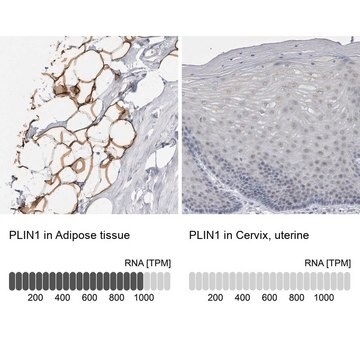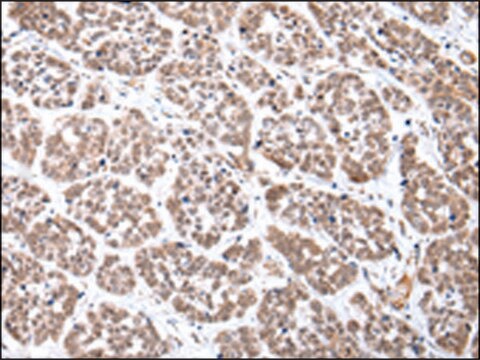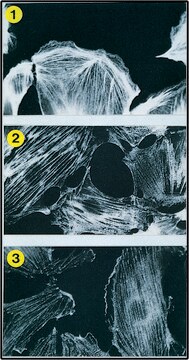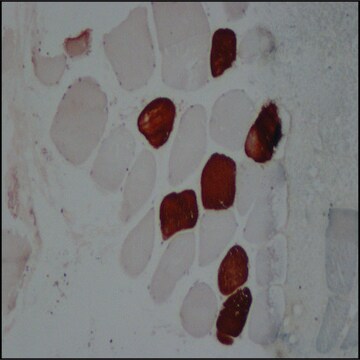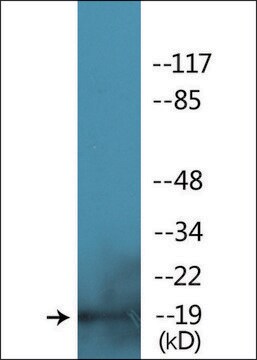おすすめの製品
由来生物
rabbit
品質水準
抗体製品の状態
affinity purified immunoglobulin
抗体製品タイプ
primary antibodies
クローン
polyclonal
精製方法
affinity chromatography
交差性
rat, human, mouse
メーカー/製品名
Chemicon®
テクニック
immunocytochemistry: suitable
NCBIアクセッション番号
UniProtアクセッション番号
輸送温度
wet ice
ターゲットの翻訳後修飾
unmodified
遺伝子情報
human ... FOXA2(3170)
mouse ... Foxa2(15376)
特異性
Recognizes FOXA2. The calculated molecular weight is ~48.3 kDa.
免疫原
Synthetic peptide corresponding to amino acids 350-361 of human and rat FOXA2 (LGPPHHPGLPPE).
アプリケーション
Research Category
エピジェネティクス及び核内機能分子
エピジェネティクス及び核内機能分子
Research Sub Category
転写因子
転写因子
Anti-FOXA2 Antibody is a Rabbit Polyclonal Antibody for detection of FOXA2 also known as Forkhead Box Protein A2, Hepatocyte Nuclear Factor 3-beta, HNF3B & has been validated in ICC.
Immunocytochemistry: 1/200 to 1/1000.
Optimal dilutions must be determined by the user.
Optimal dilutions must be determined by the user.
物理的形状
Affinity purified immunogloublin precipitated in a solution of 50% saturated ammonium sulfate and PBS containing no preservatives.
保管および安定性
Maintain unopened vial at -20°C for up to 6 months. Avoid repeated freeze/thaw cycles.
The rehydrated antibody solutions can be stored undiluted at 2-8°C for 2 months without any significant loss of activity. Note, the solution is not sterile, thus care should be taken if product is stored at 2-8°C.
For storage at -20°C, the addition of an equal volume of glycerol can be used, however, it is recommended that ACS grade or higher glycerol be used, as significant loss of activity can occur if the glycerol used is not of high quality.
For freezing, it is recommended that the rehydrated antibody solution be further diluted 1:1 with a 2% BSA (fraction V, highest-grade available) solution made with the rehydration buffer. The resulting 1% BSA/antibody solution can be aliquoted and stored frozen at -70°C for up to 6 months. Avoid repeated freeze/thaw cycles
PREPARATION AND USE:
To reconstitute the antibody, centrifuge the antibody vial at moderate speed (5,000 rpm) for 5 minutes to pellet the precipitated antibody product. Carefully remove the ammonium sulfate/PBS buffer solution and discard. It is not necessary to remove all of the ammonium sulfate/PBS solution: 10 μL of residual ammonium sulfate solution will not effect the resuspension of the antibody. Do not let the protein pellet dry, as severe loss of antibody reactivity can occur.
Resuspend the antibody pellet in any suitable biological buffer, standard PBS or TBS (pH 7.3-7.5) are typical. Volumes required are not critical but it is suggested that the final antibody concentration be between 0.1 mg/mL and 1.0 mg/mL. For example, to achieve a1 mg/mL concentration with 50 μg of precipitated antibody, the amount of buffer needed would be 50 μL.
Carefully add the liquid buffer to the pellet. DO NOT VORTEX. Mix by gentle stirring with a wide pipet tip or gentle finger-tapping. Let the precipitated antibody rehydrate for 1 hour at 4-25°C prior to use. Small particles of precipitated antibody that fail to resuspend are normal. Vials are overfilled to compensate for any losses.
The rehydrated antibody solutions can be stored undiluted at 2-8°C for 2 months without any significant loss of activity. Note, the solution is not sterile, thus care should be taken if product is stored at 2-8°C.
For storage at -20°C, the addition of an equal volume of glycerol can be used, however, it is recommended that ACS grade or higher glycerol be used, as significant loss of activity can occur if the glycerol used is not of high quality.
For freezing, it is recommended that the rehydrated antibody solution be further diluted 1:1 with a 2% BSA (fraction V, highest-grade available) solution made with the rehydration buffer. The resulting 1% BSA/antibody solution can be aliquoted and stored frozen at -70°C for up to 6 months. Avoid repeated freeze/thaw cycles
PREPARATION AND USE:
To reconstitute the antibody, centrifuge the antibody vial at moderate speed (5,000 rpm) for 5 minutes to pellet the precipitated antibody product. Carefully remove the ammonium sulfate/PBS buffer solution and discard. It is not necessary to remove all of the ammonium sulfate/PBS solution: 10 μL of residual ammonium sulfate solution will not effect the resuspension of the antibody. Do not let the protein pellet dry, as severe loss of antibody reactivity can occur.
Resuspend the antibody pellet in any suitable biological buffer, standard PBS or TBS (pH 7.3-7.5) are typical. Volumes required are not critical but it is suggested that the final antibody concentration be between 0.1 mg/mL and 1.0 mg/mL. For example, to achieve a1 mg/mL concentration with 50 μg of precipitated antibody, the amount of buffer needed would be 50 μL.
Carefully add the liquid buffer to the pellet. DO NOT VORTEX. Mix by gentle stirring with a wide pipet tip or gentle finger-tapping. Let the precipitated antibody rehydrate for 1 hour at 4-25°C prior to use. Small particles of precipitated antibody that fail to resuspend are normal. Vials are overfilled to compensate for any losses.
法的情報
CHEMICON is a registered trademark of Merck KGaA, Darmstadt, Germany
免責事項
Unless otherwise stated in our catalog or other company documentation accompanying the product(s), our products are intended for research use only and are not to be used for any other purpose, which includes but is not limited to, unauthorized commercial uses, in vitro diagnostic uses, ex vivo or in vivo therapeutic uses or any type of consumption or application to humans or animals.
適切な製品が見つかりませんか。
製品選択ツール.をお試しください
保管分類コード
12 - Non Combustible Liquids
WGK
WGK 2
引火点(°F)
Not applicable
引火点(℃)
Not applicable
適用法令
試験研究用途を考慮した関連法令を主に挙げております。化学物質以外については、一部の情報のみ提供しています。 製品を安全かつ合法的に使用することは、使用者の義務です。最新情報により修正される場合があります。WEBの反映には時間を要することがあるため、適宜SDSをご参照ください。
Jan Code
AB4125:
試験成績書(COA)
製品のロット番号・バッチ番号を入力して、試験成績書(COA) を検索できます。ロット番号・バッチ番号は、製品ラベルに「Lot」または「Batch」に続いて記載されています。
Maryam Mahmoodinia Maymand et al.
Artificial cells, nanomedicine, and biotechnology, 46(4), 853-860 (2017-07-12)
The application of stem cells holds great promises in cell and tissue transplants. This study was designed to compare the hepatogenic differentiation of iPSCs on aligned PES/COL versus random. Aligned and random PES/COL nanofibrus scaffolds were fabricated by electrospining and
Abdulshakour Mohammadnia et al.
Journal of cellular physiology, 231(9), 1994-2006 (2016-01-13)
The generation of definitive endoderm (DE) from pluripotent stem cells (PSCs) is a fundamental stage in the formation of highly organized visceral organs, such as the liver and pancreas. Currently, there is a need for a comprehensive study that illustrates
Saiyong Zhu et al.
Nature protocols, 10(7), 959-973 (2015-06-05)
Induction of tissue-specific cell types via a conventional transdifferentiation strategy typically uses overexpression of the corresponding lineage-specific transcription factors. Alternatively, somatic cells can be temporarily activated via a common set of reprogramming factors into a transition state, which can then
Pradeep A Subramani et al.
Malaria journal, 19(1), 214-214 (2020-06-24)
Vivax malaria is associated with significant morbidity and economic loss, and constitutes the bulk of malaria cases in large parts of Asia and South America as well as recent case reports in Africa. The widespread prevalence of vivax is a
Saiyong Zhu et al.
Nature, 508(7494), 93-97 (2014-02-28)
Human induced pluripotent stem cells (iPSCs) have the capability of revolutionizing research and therapy of liver diseases by providing a source of hepatocytes for autologous cell therapy and disease modelling. However, despite progress in advancing the differentiation of iPSCs into
ライフサイエンス、有機合成、材料科学、クロマトグラフィー、分析など、あらゆる分野の研究に経験のあるメンバーがおります。.
製品に関するお問い合わせはこちら(テクニカルサービス)

